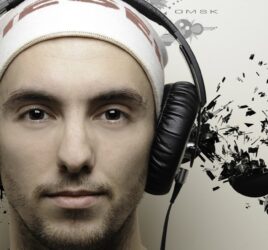
The Magic Healing Powers of Rapid Eye Movement Sleep
| An embarrassing social blunder at your grandma’s birthday party; the intense euphoria of your first love; the defeat after a failing grade in a critical course – these are examples of highly emotional events that can become deeply ingrained in memory. You are likely to still remember which sensations you experienced: a pounding heart, a flushed face, and a dropping feeling in your stomach as you spilled a glass of strawberry juice in the lap of your grandma’s new white dress. However, you may also notice that you do not feel the same intense visceral reactions anymore – your heart may not beat as fast and you do not start sweating as profusely as you did when you saw the look on granny’s face. You may attribute such changes to the months or years that have passed since the difficult moment, for as the old saying goes, “time heals all wounds”. However, this emotional dampening is also one of the many mysterious benefits of our nightly slumber (e.g., van der Helm & Walker, 2010).
Rapid eye movement (REM) sleep represents one of the stages of sleep, and an extraordinary one at that (e.g., Steriade et al., 1996). Even though we are fast asleep, our brain lights up with activity during REM, especially in areas associated with emotional processing like the amygdala. During REM sleep, our brain essentially sorts through all the emotional experiences accumulated over the day and reactivates them (van der Helm & Walker, 2010). Importantly, whereas our waking stress response involves noradrenaline increases to prepare the body for fight or flight, the repeated reactivation of the stressful memory in REM involves decreased levels of noradrenaline (Pace-Schott & Hobson, 2002). Thus, emotional memories are reactivated in the safe space of REM sleep, stripped of their stressful hull, and progress into long-term memory storage so that you may still blush when remembering your debacles but are less likely to be completely overwhelmed by the fight or flight response. The day after an emotional experience, you may notice that you likely think more rationally and less emotionally about the event, supporting the notion of sleeping on important decisions.
There is ample evidence that REM provides a “nocturnal soothing balm” (Walker, 2017). In one study, two groups of healthy adults were shown emotionally charged pictures while they were in an fMRI to measure their brain’s emotional reactivity towards these images (van der Helm et al., 2011). The only difference between the groups was the time at which they initially saw the pictures, with one seeing them in the morning and the other at night. This meant that one group slept before the second session whereas the other proceeded with their day as usual. Both groups saw the pictures again 12 hours later and, sure enough, the group that slept showed less intense neural reactions to the pictures, while the group that had stayed awake showed no dampening of reactivity. These differences were not only detectable through the fMRI, but also on self-report of the participants’ subjective emotional intensity ratings. Those who slept during the 12-hour time frame stated that they felt less emotional, whereas the other group reported no changes. Importantly, the largest decrease in emotional reactivity was found in participants whose noradrenaline activity slowed down the most during REM.
The benefits of REM sleep on emotional memories elicit the question of what happens when this mechanism fails. Sleep scientists have argued that poor REM modulation of emotional memories may contribute to Posttraumatic Stress Disorder (PTSD, e.g. van der Helm & Walker, 2010). People with PTSD often experience flashbacks and intrusions of their traumatic memories (American Psychiatric Association, 2013). Such intrusions are extremely vivid, even though the events may be decades old. This suggests that the decoupling of emotion and semantic memory during REM sleep has not taken place successfully, as the memory still elicits such strong emotional responses. Supporting this perspective, PTSD sufferers have shown increased levels of noradrenaline during sleep (Mellman et al., 1995). The brain will continue to flag the memory as emotionally charged the following night and attempt to reprocess it. Due to the heightened levels of noradrenaline, the individual is caught in a spiral of reoccurring nightmares and restless REM sleep. A drug originally intended to lower blood pressure in war veterans (Prazosin, e.g., Taylor et al., 2008) targeted precisely this hyperactivity of noradrenaline. The results of this study showed that not only did the drug alleviate hypertension by slowing the noradrenergic activity, but it also rid patients of their traumatic nightmares.
So perhaps health care providers need to better recognise how essential sleep is and enhance individual resilience through sleep-promoting habits (Germain, 2013). Restoring and improving sleep soon after bad experiences may ultimately speed up recovery and allow us to function in a world full of emotional responses.
References American Psychiatric Association. (2013). Diagnostic and Statistical Manual of Mental Disorders (5th ed.). Publisher. Germain, A. (2013). Sleep disturbances as the hallmark of PTSD: Where are we now? American Journal of Psychiatry, 170(4), 372–382. https://doi.org/10.1176/appi.ajp.2012.12040432 Mellman, T. A., Kumar, A., Kulick-Bell, R., Kumar, M., & Nolan, B. (1995). Nocturnal/daytime urine noradrenergic measures and sleep in combat-related PTSD. Biological Psychiatry, 38(3), 174–179. https://doi.org/10.1016/0006-3223(94)00238-X Pace-Schott, E. F., & Hobson, J. A. (2002). The neurobiology of sleep: Genetics, cellular physiology and subcortical networks. Nature Reviews Neuroscience, 3(8), 591–605. https://doi.org/10.1038/nrn895 Steriade, M., Amzica, F., & Contreras, D. (1996). Synchronization of fast (30-40 Hz) spontaneous cortical rhythms during brain activation. Journal of Neuroscience, 16(1), 392–417. https://doi.org/10.1523/jneurosci.16-01-00392.1996 Taylor, F. B., Martin, P., Thompson, C., Williams, J., Mellman, T. A., Gross, C., Peskind, E. R., & Raskind, M. A. (2008). Prazosin Effects on Objective Sleep Measures and Clinical Symptoms in Civilian Trauma Posttraumatic Stress Disorder: A Placebo-Controlled Study. Biological Psychiatry, 63(6), 629–632. https://doi.org/10.1016/j.biopsych.2007.07.001 van der Helm, Els; Walker, M. P. (2010). Overnight Therapy? The Role of Sleep in Emotional. Psychological Bulletin, 135(5), 731–748. https://doi.org/10.1037/a0016570.Overnight van der Helm, E., Yao, J., Dutt, S., Rao, V., Saletin, J. M., & Walker, M. P. (2011). REM sleep depotentiates amygdala activity to previous emotional experiences. Current Biology, 21(23), 2029–2032. https://doi.org/10.1016/j.cub.2011.10.052 Walker, M. P. (2017). Why we sleep: Unlocking the power of sleep and dreams. Scribner. https://doi.org/10.3399/bjgp18X695609 Note: Featured image by https://unsplash.com/photos/YyZFSb_U6N4, Unsplash License. |



